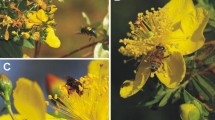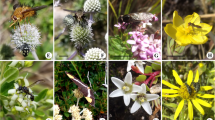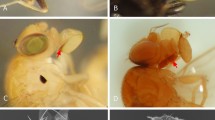Abstract
The reproductive biology of the cassava genus (Manihot, Euphorbiaceae) remains unknown, despite its relevance to humanity. Here, we investigated the pollination system of two cassava wild relatives concerning the filtering of visitors in unisexual flowers, the specialization–generalization degree, and verified the dependency on pollinators for seed production. We studied two monoecious species M. violacea and M. oligantha on floral traits differences and visitors during flowering periods in natural conditions. For specialization–generalization degree analysis, we grouped pollinators into functional groups. We performed hand pollination treatments to verify the mating system. About half of floral visitors visited a floral type exclusively. The sexually dimorphic floral display contributed to filtering abundant pollinators, whereas nectar traits acted as attractant filter. In addition to polysaccharides, a remarkable presence of alkaloids and terpenes was observed in the nectary tissue of both male and female flowers. The species exhibited specialization associated with distinct functional groups, M. violacea with bees and M. oligantha with flies. The two Manihot species presented self-compatibility and depend on pollinators to produce seeds and the threatened species M. oligantha manifested pollen limitation. Our findings evidence conspicuous filtering of visitors and consequently, a specialized pollination system emerged for the two Manihot species despite the apparent generalist flowers. The reproductive success relying on groups of abundant pollinators suggests a threatening scenario to cassava wild relatives due to the worldwide decline of insect abundance.





Similar content being viewed by others
Data availability
Not applicable.
Code availability
Not applicable.
References
Aizen MA, Aguiar S, Biesmeijer JC et al (2019) Global agricultural productivity is threatened by increasing pollinator dependence without a parallel increase in crop diversification. Glob Chang Biol 25:3516–3527
Armbruster WS (2014) Floral specialization and angiosperm diversity: phenotypic divergence, fitness trade-offs and realized pollination accuracy. AoB Plants 6:1–24
Armbruster WS (2017) The specialization continuum in pollination systems: diversity of concepts and implications for ecology, evolution and conservation. Funct Ecol 31:88–100
Ashworth L, Aguilar R, Mart S (2015) Pollination syndromes: a global pattern of convergent evolution driven by the most effective pollinator. Evolutionary biology: biodiversification from genotype to phenotype. Springer, Cham, pp 203–224
Bawa KS (1980) Evolution of dioecy in flowering plants. Annu Rev Ecol Syst 11:15–39
Bell G, Lefebvre L, Giraldeau LA, Weary D (1984) Partial preference of insects for the male flowers of an annual herb. Oecologia 64:287–294
Biesmeijer JC, Richter JAP (1999) Niche differentiation in nectar-collecting stingless bees: the influence of morphology, oral choice and interference competition. Ecol Entomol 24:380–388
Calaça PC, Schlindwein CS, Bastos EMAF (2018) Discriminating unifloral honey from a dioecious mass flowering tree of Brazilian seasonally dry tropical forest through pollen spectra: consequences of honeybee preference for staminate flowers. Apidologie 49:705–720
Camadro EL (2012) Relevance of the genetic structure of natural populations, and sampling and classification approaches for conservation and use of wild crop relatives: potato as an example. Botany 90:1065–1072
Campbell AJ, Jaffé R, Carvalheiro LG et al (2018) Anthropogenic disturbance of tropical forests threatens pollination services to açaí palm in the Amazon river delta. J Appl Ecol 55:1725–1736
Carlson JE, Harms KE (2006) The evolution of gender-biased nectar production in hermaphroditic plants. Bot Rev 72:179–205
Castañeda-Álvarez NP, Khoury CK, Achicanoy HA et al (2016) Global conservation priorities for crop wild relatives. Nat Plants 2:1–6
Chacoff N, Resasco J, Vázquez DP (2018) Interaction frequency, network position, and the temporal persistence of interactions in a plant–pollinator network. Ecology 99:21–28
Charlesworth D (1993) Why are unisexual flowers associated with wind pollination and unspecialized pollinators? Am Nat 141:481–490
Cook D, Manson JS, Gardner DR et al (2013) Norditerpene alkaloid concentrations in tissues and floral rewards of larkspurs and impacts on pollinators. Biochem Syst Ecol 48:123–131
David R, Carde JP (1964) Coloration différentielle dês inclusions lipidique et terpeniques dês pseudophylles du Pin maritime au moyen du reactif Nadi. C R Acad Sci 258:1338–1340
Delph LF, Galloway LF, Stanton ML (1996) Sexual dimorphism in flower size. Am Nat 148:299–320
Dinno A (2017) dunn.test: Dunn’s test of multiple comparisons using rank sums. R package version 1.3.5
Duputié A, Salick J, Mckey D (2011) Evolutionary biogeography of Manihot (Euphorbiaceae), a rapidly radiating Neotropical genus restricted to dry environments. J Biogeogr 1:1–11
Endress PK (1994) Diversity and evolutionary biology of tropical flowers. Cambridge University Press, New York
Engel EC, Irwin RE (2003) Linking pollinator visitation rate and pollen receipt. Am J Bot 90:1612–1618
Faegri K, van der Pijl L (1979) The principles of pollination ecology. Pergamon Press, New York
Fenster CB, Armbruster WS, Wilson P et al (2004) Pollination syndromes and floral specialization. Annu Rev Ecol Evol Syst 35:375–403
Ferrer MM, Good-Avila SV, Montaña C et al (2009) Effect of variation in self-incompatibility on pollen limitation and inbreeding depression in Flourensia cernua (Asteraceae) scrubs of contrasting density. Ann Bot 103:1077–1089
Fisher DB (1968) Protein staining of ribboned epon sections for light microscopy. Histochemie 16:92–96
Flaig IC, Aguilar I, Schmitt T, Jarau S (2016) An unusual recruitment strategy in a mass-recruiting stingless bee, Partamona orizabaensis. J Comp Physiol A 202:679–690
Fox J, Weisberg S (2011) An R companion to applied regression, 2nd edn. Thousand Oaks, Sage Publications
Fox F, Weisberg S, Price B (2018) carData: companion to applied regression data sets. R package version 3.0-2
Furr M, Mahlberg PG (1981) Histochemical analyses of laticifers and glandular trichomes in Cannabis sativa. J Nat Prod 44:153–159
Glinos E, Condat E, Mulieri P, Ashworth L (2019) Essential dependence on wild pollination service: a medicinal plant under threat Minthostachys verticillata (Lamiaceae). Arthropod Plant Interact 13:865–874
Gong Y, Huang S (2009) Floral symmetry: pollinator-mediated stabilizing selection on flower size in bilateral species. Proc R Soc Lond B 276:4013–4020
Gregory M, Baas P (1989) A survey of mucilage cells in vegetative organs of the dicotyledons. Isr J Bot 38:125–174
Hallmann CA, Sorg M, Jongejans E et al (2017) More than 75 percent decline over 27 years in total flying insect biomass in protected areas. PLoS One 12:e0185809
Hartig F (2019) DHARMa: residual diagnostics for hierarchical (multi-level/mixed) regression models. R package version 0.2.4
Heinrich B, Raven PH (1972) Energetics and pollination ecology. Science 176:597–602
Herrera CM (1988) Variation in mutualisms: the spatio-temporal mosaic of a pollinator assemblage. Biol J Linn Soc 35:95–125
Hopkins R, Rausher MD (2012) Pollinator-mediated selection on flower color allele drives reinforcement. Science 335:1090–1092
Hrncir M, Maia-silva C (2013) The fast versus the furious—on competition, morphological foraging traits, and foraging. In: Vit P, Roubik DW (eds) Stingless bees process honey and pollen in cerumen pots. Facultad de Farmacia y Bioanálisis, Universidad de Los Andes, pp 1–13
International Union for Conservation of Nature (1997) Red List of Threatened Plants. Magnoliopsida. Compiled by the World Conservation Monitoring Center. IUCN—The World Conservation Union, Gland, Switzerland and Cambridge, UK
Johansen DA (1940) Plant microtechnique. McGraw-Hill Book Co, New York
Johnson SD, Hargreaves A, Brown M (2006) Dark, bitter-tasting nectar functions as a filter of flower visitors in a bird-pollinated plant. Ecology 87:2709–2716
Joly S, Lambert F, Alexandre H et al (2018) Greater pollination generalization is not associated with reduced constraints on corolla shape in Antillean plants. Evolution 72:244–260
Kawagoe T, Suzuki N (2003) Flower-size dimorphism avoids geitonogamous pollination in a nectarless monoecious plant Akebia quinata. Int J Plant Sci 164:893–897
Kessler D, Baldwin IT (2007) Making sense of nectar scents: the effects of nectar secondary metabolites on floral visitors of Nicotiana attenuata. Plant J 49:840–854
Knight TM, Steets JA, Vamosi JC et al (2005) Pollen limitation of plant reproduction: pattern and process. Annu Rev Ecol Evol Syst 36:467–497
Kole C (2014) Wild crop relatives: genomic and breeding resource. In: Kole C (ed) Industrial crops industrial crops. Springer, pp 197–218
Lai H, Chen X, Chen Z et al (2014) In situ pollen germination and artificial pollination compatibility in cassava (Manihot esculenta Crantz). Appl Mech Mater 651:245–251
Lawless JF (1987) Negative binomial and mixed Poisson regression. Can J Stat 15:209–225
Lázaro A, Hegland SJ, Totland O (2008) The relationships between floral traits and specificity of pollination systems in three Scandinavian plant communities. Oecologia 157:249–257
Leonhardt SD (2017) Chemical ecology of stingless bees. J Chem Ecol 43:385–402
Li J, Huang S (2009) Effective pollinators of Asian sacred lotus (Nelumbo nucifera): contemporary pollinators may not reflect the historical pollination syndrome. Ann Bot 104:845–851
Lillie RD (1965) Histopathologic technic and practical histochemistry. McGraw-Hill, New York
Liu F, Yue XL, Chen JM, Wang QF (2008) Gender modification in a monoecious species Sagittaria potamogetifolia (Alismataceae). Plant Ecol 199:217–223
Manihot in Flora do Brasil 2020 em construção. Jardim Botânico do Rio de Janeiro. Disponível em: http://reflora.jbrj.gov.br/reflora/floradobrasil/FB17591. Accessed on 24 Oct 2020
Martén-Rodríguez S, Almarales-Castro A, Fenster CB (2009) Evaluation of pollination syndromes in Antillean Gesneriaceae: evidence for bat, hummingbird and generalized flower. J Ecol 97:348–359
Martén-Rodríguez S, Fenster CB, Agnarsson I et al (2010) Evolutionary breakdown of pollination specialization in a Caribbean plant radiation. New Phytol 188:403–417
Martén-Rodríguez S, Quesada M, Castro A et al (2015) A comparison of reproductive strategies between island and mainland Caribbean Gesneriaceae. J Ecol 103:1190–1204
McManus JFA (1948) Histological and histochemical uses of periodic acid. Stain Technol 23:99–108
Mitchell RJ (2004) Heritability of nectar traits: why do we know so little? Ecology 85:1527–1533
Nassar NMA, Carvalho CGP (1990) Insetos polinizadores e seus comportamentos nas espécies silvestres da mandioca, Manihot spp. Cien Cult 42:703–705
Nassar NMA, Bomfim NN, Mendoza FJM, Sano NR (2012) Some interesting cassava cultivars: 9—ICB 300. Gene Conserve 11:3–6
Niemirski R, Zych M (2011) Fly pollination of dichogamous Angelica sylvestris (Apiaceae): how (functionally) specialized can a (morphologically) generalized plant be? Plant Syst Evol 294:147–158
Olesen JM, Dupont YL, Ehlers BK, Hansen DM (2007) The openness of a flower and its number of flower-visitor species. Taxon 56:729–736
Oliveira PS, Marquis RJ (2002) The Cerrados of Brazil: ecology and natural history of a Neotropical savanna. Columbia University Press, New York
Ollerton J, Alarcon R, Waser NM et al (2009) A global test of the pollination syndrome hypothesis. Ann Bot 103:1471–1480
Ollerton J, Rech AR, Waser NM, Price MV (2015) Using the literature to test pollination syndromes—some methodological cautions. J Pollinat Ecol 16:119–125
Parachnowitsch AL, Kessler A (2010) Pollinators exert natural selection on flower size and floral display in Penstemon digitalis. New Phytol 188:393–402
Pearse AGE (1985) Histochemistry: theoretical and applied. Churchill Livingstone, London
R Core Team (2019) R: a language and environment for statistical computing. R Foundation for Statistical Computing, Vienna
Raguso RA (2004) Why are some floral nectars scented ? Ecology 85:1486–1494
Raguso RA (2020) Don’ t forget the flies: dipteran diversity and its consequences for floral ecology and evolution. Appl Entomol Zool 55:1–7
Reverté S, Retana J, Gómez JM, Bosch J (2016) Pollinators show flower colour preferences but flowers with similar colours do not attract similar pollinators. Ann Bot 118:249–257
Rogers DJ, Appan SG (1973) Manihot and Manihotoides (Euphorbiaceae): a computer assisted study. Flora Neotrop monograph, vol 13. Hafner Press, New York
Rosas-Guerrero V, Aguilar R, Martén-Rodríguez S et al (2014) A quantitative review of pollination syndromes: do floral traits predict effective pollinators? Ecol Lett 17:388–400
Roubik DW, Yanega D, Aluja S et al (1995) On optimal nectar foraging by some tropical bees (Hymenoptera: Apidae). Apidologie 26:197–211
Sargent RD (2004) Floral symmetry affects speciation rates in angiosperms. Proc R Soc Lond B 271:603–608
Schiestl FP, Johnson SD (2013) Pollinator-mediated evolution of floral signals. Trends Ecol Evol 28:307–315
Sharma MV, Shaanker RU, Leather SR et al (2011) Floral resources, pollinators and fruiting in a threatened tropical deciduous tree. J Plant Ecol 4:259–267
Silva MJ, Sodré RC (2014) A dwarf species of Manihot Mill. (Euphorbiaceae s. s.) from the highlands of Goiás, Brazil. Syst Bot 39:222–226
Simon MF, Reis TS, Mendoza FJM et al (2018) Conservation assessment of cassava wild relatives in central Brazil. Biodivers Conserv 29:1589–1612
Totland Ø, Sottocornola M (2001) Pollen limitation of reproductive success in two sympatric alpine willows (Salicaceae) with contrasting pollination strategies. Am J Bot 88:1011–1015
Trigo JR (2000) The chemistry of antipredator defense by secondary compounds in Neotropical Lepidoptera: facts, perspectives and caveats. J Braz Chem Soc 11:551–561
Vamosi JC, Otto SP (2002) When looks can kill: the evolution of sexually dimorphic floral display and the extinction of dioecious plants. Proc R Soc B Biol Sci 269:1187–1194
Van Etten ML, Chang S (2014) Frequency-dependent pollinator discrimination acts against female plants in the gynodioecious Geranium maculatum. Ann Bot 114:1769–1778
Vázquez DP, Morris WF, Jordano P (2005) Interaction frequency as a surrogate for the total effect of animal mutualists on plants. Ecol Lett 8:1088–1094
Venables WN, Ripley BD (2002) Modern applied statistics with S. Springer, New York
Vieira LDJ, Soares TL, Rossi ML et al (2012) Viability, production and morphology of pollen grains for different species in the genus Manihot (Euphorbiaceae). Acta Bot Bras 26:350–356
Vincent H, Wiersema J, Kell S et al (2013) A prioritized crop wild relative inventory to help underpin global food security. Biol Conserv 167:265–275
Vit P, Pedro SRM, Roubik DW (2018) Pot-pollen in stingless bee melittology. Springer, Cham
Waser NM, Chittka L, Price MV et al (1996) Generalization in pollination systems, and why it matters. Ecology 77:1043–1060
White D, Cribb BW, Heard TA (2001) Flower constancy of the stingless bee Trigona carbonaria Smith (Hymenoptera: Apidae: Meliponini). Aust J Entomol 40:61–64
Wickham H (2016) ggplot2: elegant graphics for data analysis. Springer, New York
Willmer P (2011) Pollination and floral ecology. Princeton University Press, New Jersey
Wilson TC, Conn BJ, Henwood MJ (2017) Great expectations: correlations between pollinator assemblages and floral characters in Lamiaceae. Int J Plant Sci 178:170–187
Wolff D (2006) Nectar sugar composition and volumes of 47 species of Gentianales from a southern Ecuadorian montane forest. Ann Bot 97:767–777
Zapata TR, Arroyo MTK (1978) Plant reproductive ecology of a secondary deciduous tropical forest in Venezuela. Biotropica 10:221–230
Zar JH (2010) Biostatistical analysis. Pearson Prentice Hall, New Jersey
Zhang M, He F (2017) Plant sex affects the structure of plant–pollinator networks in a subtropical forest. Oecologia 185:269–279
Acknowledgements
We are very grateful to Rocio-Perez Barrales, Aline Martins, Thaís Vasconcelos and two anonymous reviewers for their helpful comments in the manuscript. We would like to thank José Roberto Pujol, Julia Calhau, Paula Riccardi, Rosaly Rocha, Silvio Nihei for identifying Diptera specimens and Rodrigo Feitosa for identifying Formicidae. We thank Vítor Gama for his help with field work. We are thankful to Jaime Sautchuk for permitting the access and collection inside the RPPN Serra dos Topázios and to the authorities of Instituto Brasília Ambiental (IBRAM) for allowing us to work at Dom Bosco Ecological Park. The first author also thanks Coordenação de Aperfeiçoamento de Pessoal de Nível Superior—Brasil (CAPES) for the scholarship.
Funding
The first author received a scholarship of Coordenação de Aperfeiçoamento de Pessoal de Nível Superior—Brasil (CAPES) in the program Demanda Social to support her studies.
Author information
Authors and Affiliations
Contributions
All authors contributed to the study conception and design. Material preparation, data collection and analysis were performed by HCF, HC, SMG, and AJCA. The first draft of the manuscript was written by HCF and all authors commented on previous versions of the manuscript. All authors read and approved the final manuscript.
Corresponding author
Ethics declarations
Conflict of interest
The authors declare that they have no conflict of interest.
Ethical approval
Not applicable.
Consent to participate
Not applicable.
Consent for publication
Not applicable.
Additional information
Handling Editor: Isabel Alves dos Santos.
Publisher's Note
Springer Nature remains neutral with regard to jurisdictional claims in published maps and institutional affiliations.
Supplementary Information
Below is the link to the electronic supplementary material.
Rights and permissions
About this article
Cite this article
Farinasso, H.C., Consolaro, H., Gomes, S.M. et al. From generalization to pollination syndromes: filtering and dependency on functional-group of pollinators in two cassava wild relatives. Arthropod-Plant Interactions 15, 235–247 (2021). https://doi.org/10.1007/s11829-021-09811-x
Received:
Accepted:
Published:
Issue Date:
DOI: https://doi.org/10.1007/s11829-021-09811-x




